18 Dec

In the dynamic world of business transactions, understanding the roles of invoices and receipts is crucial for effective financial management. While both documents capture a transaction, they operate at different stages, providing unique sets of information crucial to the overall accounting process.
In this article, we explore the distinct purposes of invoices and receipts, exploring why both are essential components of a well-organized financial system. From initiating payments to confirming transactions and maintaining transparent records, each document plays a vital role in fostering trust, compliance, and efficient financial operations.
In the complex game of commercial transactions, let’s explore the importance of both invoices and receipts.
Invoices.
Request for Payment.
An invoice is issued before the payment is made. It serves as a formal request for payment from a customer for goods or services provided. It outlines the details of the transaction, including the due date for payment.
Legal and Record-Keeping.
Invoices serve as legal documents that establish an obligation for the buyer to pay the specified amount within a given timeframe. They are crucial for record-keeping and can be used as evidence in case of disputes or for tax purposes.
Credit Terms and Conditions
Invoices typically include payment terms, such as the due date and any applicable discounts or late fees. This helps in establishing clear expectations regarding when payment is expected and any consequences for late payments.
Tracking Sales and Revenue.
Invoices are essential for tracking sales and revenue. They provide a detailed breakdown of the products or services sold, quantity, unit price, and total amount, contributing to accurate financial reporting.
Inventory Management
In manufacturing or retail businesses, invoices contribute to inventory management. They help in tracking the movement of goods, updating stock levels, and ensuring efficient supply chain management.
Auditing and Compliance
Invoices are crucial for regulatory compliance and auditing purposes. They provide a transparent trail of financial transactions, ensuring that the business adheres to taxation and accounting standards.
Receipts.
Confirmation of Payment.
A receipt, on the other hand, is issued after the payment has been made. It serves as a confirmation that the payment has been received by the seller. It includes details such as the payment method, date, and amount paid.
Proof of Purchase.
Receipts act as proof of purchase for the buyer. They document that the buyer has fulfilled their financial obligation and can be used for returns, exchanges, or warranty claims.
Expense Tracking.
For the buyer, receipts are crucial for tracking expenses. They provide a detailed record of each transaction, making it easier for individuals and businesses to manage their finances and track expenditures.
Reconciliation.
Receipts play a role in financial reconciliation. They help in matching payments made with the corresponding invoices, ensuring that all transactions are accounted for and accurately reflected in financial records.
Customer Relation
Providing a receipt promptly enhances customer relations. It gives customers confidence that their payment has been acknowledged, contributing to a positive buying experience and potentially fostering repeat business.
Conclusion.
Invoices initiate the payment process and document the terms of the sale, receipts serve as proof of payment and are vital for tracking expenses. Having both invoices and receipts in your business ensures a comprehensive and accurate record of financial transactions, contributing to transparency, compliance, and effective financial management.
Marjina Muskaan has over 5+ years of experience writing about finance, accounting, and enterprise topics. She was previously a senior writer at Invyce.com, where she created engaging and informative content that made complex financial concepts easy to understand.
Related Post
Copyright © 2024 – Powered by uConnect



Marjina Muskaan